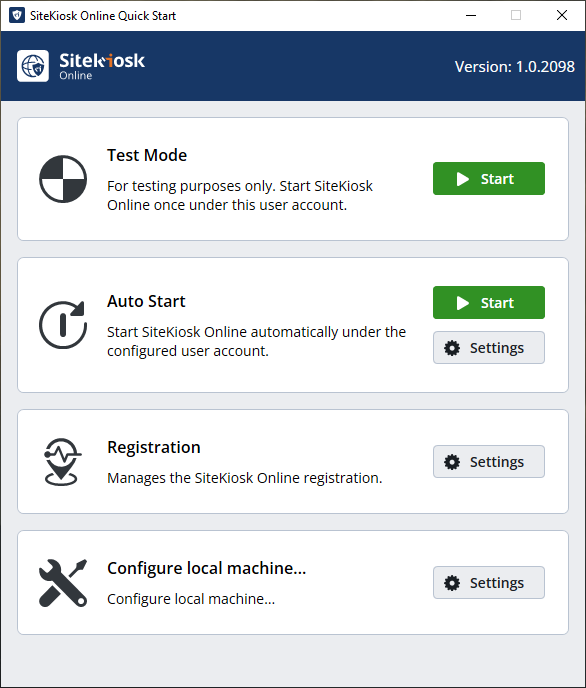Starting the client
Windows
After installing and starting the SiteKiosk Client, you will see the following menu:

Test Mode
SiteKiosk will be launched only once under the Windows administrator account applying the current configuration, for example for testing purposes.
Auto Start
Auto start is the recommended method to run SiteKiosk and should be selected for normal operating mode after you have successfully tested the configuration by starting in run-once mode. Selecting this option will have the following effects:
- SiteKiosk will be launched automatically on every system start.
- Logon will be performed automatically under the limited SiteKiosk user account.
- The Windows shell will be replaced by SiteKiosk's shell.
- The Keyboard lock will be disabled once bootup is initiated.
Under Settings the Auto-Start can also be configured for additional Windows users.
Registration
Here you can view the registration details of the SiteKiosk Online Server. It is possible to log off the client from the server and log it back on to another server.
Android
When you launch SiteKiosk Android from the application menu of your Android device, you will be asked what you want to use as the default Home Screen.
To fully enable protected kiosk mode on your tablet, you need to use SiteKiosk Client as the default Home Screen.
You will also need to select SiteKiosk Client as the default option for this action.
This will ensure that SiteKiosk will automatically restart when you reboot or turn off the device.
Note that the dialog about which app to use as the default home screen will not be displayed again until you reset the behavior, e.g. using the reset button in the Android app's settings.
SiteKiosk Android requires a number of permissions to be assigned to it. SiteKiosk will ask for these permissions on every start unless they are granted or the reminder is disabled. Please note that missing permissions will lead to a restricted functionality of SiteKiosk Android or to a cancellation of the startup process.
Note that the required permissions vary depending on the Android version in use. SiteKiosk will automatically detect all required permissions based on the Android system it is running on. You will either be presented with a direct option to allow a permission or, if that should not be possible, will be automatically send to the Android settings page for a specific permission. After applying the required setting you need to use the back button of your Android device until you are back in the startup process of SiteKiosk.
The following is a list of permissions, that require to be edited by going into the Android settings.
Permit usage access: SiteKiosk needs access to usage data in order to control other Android apps. In the Android settings under Apps with usage access the SiteKiosk entry needs to be turned on. This permission is optional. If you skip this step, SiteKiosk will deactivate a few options. SiteKiosk will automatically enable the disabled options if you assign this permission at a later time.
Allow modification of system settings: SiteKiosk needs to modify system settings in order to control the orientation of the device. In the Android settings under Can modify system settings SiteKiosk needs to be set to allow.
Permit drawing over other apps: SiteKiosk needs to be able to draw itself over other apps, in order to not fall behind an unwanted app or system dialog. In the Android settings under Apps that can draw over other apps SiteKiosk needs to be set to allow.
Allow SiteKiosk VNC service: SiteKiosk VNC service must be allowed in the accessibility settings of Android. For Android 10 and higher additional steps are required: https://www.sitekiosk.com/link/androidvncen